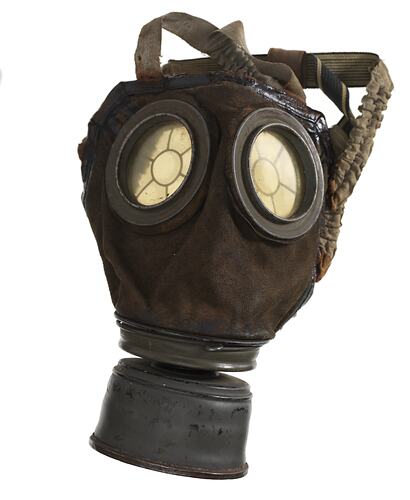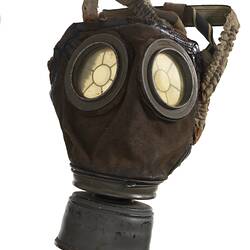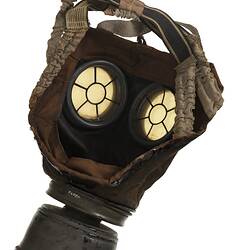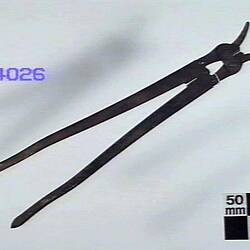Summary
Alternative Name(s): Gas Mask, Gas Respirator
German World War I respirator with leather face mask with plastic eye lenses, elasticised straps and metal air filter, captured during World War I. It is probably a Lederschutzmaske or Ledermaske (leather protection mask) respirator, introduced into German Army service in late 1917 in response to a shortage of raw materials (particularly rubber) in Germany. According to the Australian War Memorial, the clip-on extension to the canister was introduced in May 1918 to combat British Stannic Chloride and German 'Blue Cross' (Diphenylchloroarsine) 'smoke' gasses, although this proved ineffectual and restricted breathing.
Souvenirs of World War I were collected after World War I with a view to establishing an Australian war museum. In September 1917 C.W. Bean described war relics as 'sacred things' in the Commonwealth Gazette, and in 1919 went to Gallipoli as the head of the Australian Historical Mission to collect relics (as well as seeking Turkish accounts of the campaign and reporting on the condition of war graves). Bean also collected relics from other theatres of battle in World War I.
The respirator was originally part of the Australian War Museum (later the Australian War Memorial) collection when it was located at the Exhibition Buildings in Melbourne. The Australian War Museum opened in the Exhibition Building on Anzac Day 1922. Its exhibition included many war relics collected by soldiers. It was enthusiastically lauded by the press and attracted large crowds. The exhibition closed in 1925 and was moved to Sydney, where it remained for 10 years until the permanent home of the Australian War Memorial was built in Canberra.
The use of poison gases added greatly to the horrors of World War I. Several different gases were used by both sides as they refined their arsenal. These included disabling chemicals such as tear gas, the more severe blistering agent, mustard gas, and gases that were rapidly lethal such as phosgene.
Physical Description
Leather face mask. Two plastic eye lenses, elasticised straps (now very deteriorated) and detachable metal air filter, painted grey (now rusted through). Fusee spring.
More Information
-
Collecting Areas
-
Acquisition Information
Donation from Australian War Memorial (AWM), Victoria, Victoria: State War Trophy Committee, 1955
-
Place & Date Used
-
Place Made
-
Inscriptions
'Becef. A. 11295' printed on lenses (empty). Pack marked 'm516' & '19732' plus Japanese characters.
-
Classification
-
Category
-
Discipline
-
Type of item
-
Overall Dimensions
18 cm (Width), 26 cm (Height)
-
References
Fletcher, Nick, "The development of the gas mask 1915-1918", OnTarget, the journal of the Defence Materiel Organisation, February 2006. Information on C.W. Bean from Australian War Memorial web site [Link 1] accessed 23/4/2009.
-
Keywords
Gas Masks, Militaria: German, Respirators, Wars & Conflicts, World War I, 1914-1918, Gas Warfare





